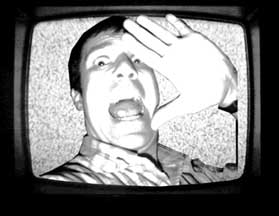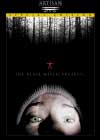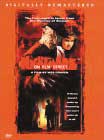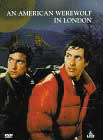 13 Frightful Films
13 Frightful Films
by Brent Seabrook
Halloween has been celebrated for at least 2,000 years. It began as the pagan festival of Samhain, where ancient Celts welcomed for one night their deceased friends and family. With the spread of Christianity, the night was transformed to All Hallow’s Eve, a day of remembrance. But for pagans and Christians alike, the focus of the holiday has remained death and the dead. Even modern Halloween traditions center around the deceased. Trick-or-treating arose in England on All Hallows’ Eve when the rich began paying the poor to pray for the dead. Costumes were worn that night to save the wandering prayer-sayers from being recognized by the ghosts that wandered abroad.
Such beliefs were easy to come by before the advent of electricity. The coming of winter posed a real threat, especially to the less fortunate. Advances in heating, lighting and food storage have since pushed our fear of winter to the periphery of our minds — but a walk down a lonely lane on a chilly autumn evening still sends a shiver up our spines.
Horror films play on the same primitive responses. Long nights and morbid traditions awaken those responses, making Halloween the perfect night for a scary movie.
Some scary movies are more suitable than others, however. Alien is one of the scariest movies ever made, but it isn’t right for Halloween. The monster is terrifying, but easily explained by science. Death remains beyond our ken, and on All Hallow’s Eve, our primitive minds demand a touch of the supernatural. That doesn’t mean a movie needs to be about ghosts or werewolves or witches. But whatever’s doing the scaring should be somewhat inexplicable.
Bay Weekly offers the following suggestions for making your Halloween frightful. We’ve limited our list to 13 films, all of which are available at Chesapeake Country video stores or on DVD at your local library. Hit the shelves the night before Halloween, to avoid the rush. Then curl up on the couch after a costume party, with a bowl of popcorn or a bit of candy held back from trick-or-treaters. Just make sure you’re not alone.
 Poltergeist
Poltergeist
The story of a suburban development built atop an Indian burial ground, Poltergeist is nowhere near as terrifying as director Tobe Hooper’s debut, The Texas Chainsaw Massacre. Poltergeist suffers from the presence of producer Steven Spielberg, who watched Hooper like a hawk throughout the movie’s making. It bears many of Spielberg’s earmarks as a result. That doesn’t mean it’s appropriate for young children — there are plenty of disturbing images — but Poltergeist isn’t frightening enough for mature horror fans, either. The film fills a prefect niche in between, however, amongst young teens and older neophytes.
PG • Runtime 114 min. • 1982
 Rosemary’s Baby
Rosemary’s Baby
For his first American film, Roman Polanski adapted Ira Levin’s bestseller about a young woman who fears her unborn baby may have satanic origins. The cast is excellent, with Mia Farrow as the young woman and John Cassavetes as her husband. Though perhaps better known from her title role in Harold and Maude, Ruth Gordon won an Oscar for her performance as the couple’s creepy neighbor. Polanski keeps the film’s proceedings firmly imbedded in reality — though his New York City seems as Gothic as a windswept moor — and wisely leaves the most graphic horrors to our imaginations. The film spawned a brood of demonic descendants throughout the mid-1970s, from The Exorcist to The Omen.
R • 136 min. • 1968
 Nosferatu
Nosferatu
Nosferatu is F. W. Murnau’s version of Bram Stoker’s Dracula. In fact, Stoker’s widow sued Murnau for copyright violation, though the film bears only a superficial resemblance to the novel. The title character was played by Max Schreck, but rumors persist that the name (German slang for “maximum fear”) was actually a pseudonym. Those rumors fuel Elias Merhige’s fictional Shadow of the Vampire, a mildly amusing account of the filming of Nosferatu. Also worth seeing is Werner Herzog’s 1979 remake, though Murnau’s silent original is ultimately spookier — perhaps because he insisted on shooting at actual central European locations, which lends a documentary quality to the film. Or perhaps it’s the silence itself, which leaves plenty of room for the imagination to maneuver. Though technically primitive, the film’s special effects remain strangely effective, and Schreck’s makeup (if that’s what it was) has never been beat.
Unrated • 75 min. • 1922
 Halloween
Halloween
Though it may at first seem to lack a touch of the supernatural, Halloween — unlike recent films about serial killers — makes little attempt to humanize its masked antagonist. Director John Carpenter borrows elements from Alfred Hitchcock’s Psycho, but — whether by accident or design — fails to explain away the actions of his killer. Michael Myers sets about slaying the teenagers of Haddonfield, Illinois, with a motive flimsier than Dracula’s: his human form belies a force no more explicable than a tornado. Carpenter added elements of his own devising, including shots from the killer’s point of view, the sound of the killer’s breathing and — most effective of all — glimpses of the killer lurking in the background. The result is truly terrifying, even viewed repeatedly. Halloween spawned six sequels and a legion of imitators, including Friday the 13th.
R • 101 min. • 1978
 The Blair Witch Project
The Blair Witch Project
This movie assumes what you can’t see is far scarier than what you can. If you agree with that premise, The Blair Witch Project is guaranteed to scare you silly. It poses as a documentary, ostensibly edited together from footage found in the woods of western Maryland. Directors Daniel Myrick and Eduardo Sanchez actually relied on documentary techniques to make the movie. They abandoned three actors in the woods with video cameras, camping supplies and a list of instructions. The result is something like Survivor with an unseen antagonist. In fact, the film’s villain is never seen, only heard — creeping around in the darkness and screaming in the distance. It also leaves a trail of inexplicable artifacts, including an unidentifiable piece of bloody flesh. All this tends to drive imaginative viewers to the brink but holds little interest for literal-minded folks.
R • 86 min. • 1999
 Suspiria
Suspiria
Few Americans are familiar with Dario Argento; art-house regulars might remember his tongue-in-cheek portrayal in Pedro Almodovar’s Tie Me Up, Tie Me Down, but probably aren’t aware that the B-movie director in that film was inspired by a real person. Besides Almodovar, Argento is Spain’s most popular director, and his most famous work — at least, on this side of the Atlantic — is Suspiria. The movie’s plot isn’t much — an American ballet student is accepted at a prestigious German dance school run by a coven of murderous witches. On top of this simple foundation, Argento builds a Baroque tower of horror. He blatantly disregards reality to shock, scare and entertain — all of which Suspiria does, in spades.
R • 97 min. • 1977
 The Shining
The Shining
Stephen King calls The Shining the most beautiful and least frightening movie made from his writing, but millions of viewers disagree. True, Stanley Kubrick excised the novel’s blatantly paranormal elements, but he pulls no punches when telling King’s tale of madness and murder. Jack Nicholson delivers a deservedly famous performance as a frustrated writer who works as caretaker of a snowbound hotel. Kubrick’s camera lends life to the hotel itself, creating a presence more threatening than any ghost, and presents horrific events with cool detachment, like an English butler presenting a severed head.
R • 146 min. • 1980
 A Nightmare on Elm Street
A Nightmare on Elm Street
Wes Craven is a true master of the horror film. His films have stretched the limits of the genre, but none approach the style and sheer terror of A Nightmare on Elm Street. The film mixes the visceral depravity of Craven’s Last House on the Left with the intellectual self-awareness of his more-recent Scream, but its ability to frighten arises directly from its premise — burned alive by angry parents, a child molester haunts the dreams of their surviving kids. Craven created one of the most memorable villains of all time — the razor-fingered Freddie Kruger — and deftly blurred the line between dream and reality. Don’t rent this one if you want to sleep before Thanksgiving.
R • 91 min. • 1984
 Evil Dead 2
Evil Dead 2
Sam Raimi’s Evil Dead is an intelligent, creative film about the horrors that befall a bunch of kids who stumble across a forgotten book of incantations. More intelligent and more creative is Raimi’s Evil Dead 2, which is more of a remake than a sequel. Cable TV regular Bruce Campbell outdoes Jim Carey as the possessed protagonist, but the star of the show is Raimi’s camera; it flies around the set as if on a trapeze, zooming in and out on ridiculous stunts and comedic monstrosities. The result is more side-splitting than hair-raising, but the sheer kinetic energy of the film is worth the price of a rental. A second sequel followed, but a better substitute, should someone beat you to the punch, is Peter Jackson’s Dead-Alive (Jackson, who directed The Lord of the Rings, was influenced by Raimi, who directed Spiderman).
R • 85 min. • 1987
 The Birds
The Birds
Made just after Psycho, Alfred Hitchcock’s The Birds is ultimately the more frightening of the two films. The crude black-and-white photography, claustrophobic sets and menacing music of the former are hard to beat, but Psycho is imbued with a logic and a morality that sap some of its strength. The Birds offers no such refuge; birds simply start slaughtering people, for no apparent reason. Hitchcock builds that simple theme into a nearly unbearable crescendo. There is no music; Bernard Herrmann, who wrote the music for Psycho, instead orchestrated sounds made by birds into a sort of soundtrack. And while some of Hitchcock’s cinematic techniques seem laughably primitive by today’s standards, most are more than effective — the near-silent finale in particular.
PG13 • 119 min. • 1963
 Night of the Living Dead
Night of the Living Dead
George Romero’s Night of the Living Dead is cheesy, amateurish and one of the most unsettling movies ever made. The premise is laughable — flesh-eating zombies attack an isolated farmhouse — but the grainy black-and-white photography and amateur acting led the film a certain realism, especially apparent when the zombies hunker down to munch on pieces of their victims. More disturbing than any single image, however, is the film’s sense of futility; the zombie attack is inexplicable, and the zombies themselves prove unstoppable, growing stronger and stronger until they overwhelm and destroy the bickering, impotent humans. If you like your horror strong and bitter, this is your cup of tea.
Unrated • 96 min. • 1968
 The Haunting
The Haunting
Often lost between his full-color musical blockbusters, West Side Story and The Sound of Music, Robert Wise’s The Haunting is a minor masterpiece of psychological horror. His hand-held, black-and-white photography balances the ensemble cast’s over-the-top acting. A skeptic, a professor and two psychics investigate a haunted house, but much like The Shining, the film’s real tensions arise amongst the investigators themselves. The 1999 remake, though better acted, is nowhere near as unsettling as the original.
G • 112 min. • 1963
 An American Werewolf in London
An American Werewolf in London
Rarely does a movie strike a perfect balance between laughter and horror, but An American Werewolf in London comes close. The film follows the adventures of an American student after he’s bitten by a werewolf on the English moors. John Landis, best known for directing classic comedies like Animal House and The Blues Brothers, serves up a smooth blend of jokes and shocks. Rick Baker’s makeup effects won him an Oscar, but some have aged better than others. The ending is extraneous, but most of the movie is an able entertainment.
R • 97 min. • 1981